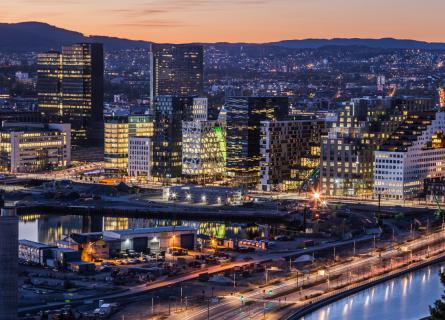
Copenhagen finds power in architecture
The shift from fossil fuel to renewable energy
In Copenhagen, the energy company HOFOR is collaborating with Gottlieb Paludan Architects, part of AFRY, in designing the new biomass-fired CHP unit, BIO4. The result is a beautiful building that demonstrates the shift from fossil fuel to renewable energy and that invites the citizens of Copenhagen to take part in the process.
By 2025, Copenhagen aims to be the world’s first carbon neutral capital city. To achieve this vision, the city is now converting one of the largest energy plants from coal- to biomass-fired boilers. With a 500 MW boiler based on sustainable biofuel, BIO4 will provide thousands of people in Copenhagen, with environmentally friendly electricity and heat.
”BIO4 is a cornerstone and a key investment in achieving our vision for the environment. 25 percent of the city’s residents will be supplied with district heating from BIO4”, explains Jakob Hougaard, a member of Copenhagen’s City Council and Board Member of the energy company HOFOR that owns the facility.
8,000 tree trunks cover the exterior
BIO4 is part of Amagerværket, a formerly coal-fired heat and power plant built in the 1970s, located just a few kilometres outside Copenhagen’s city centre. The new unit will replace the plant’s coal-fired combined heat and power unit.
The close proximity to the capital city places high environmental requirements on the building. BIO4’s advanced flue-gas treatment system is expected to reduce carbon dioxide emissions by 1.2 million tonnes per year. This corresponds to almost 40 percent of the carbon dioxide emissions in Copenhagen.
Architect agency Gottlieb Paludan Architects (GPA), part of AFRY, is responsible for the design of BIO4 and in developing the area surrounding Amagerværket. The CHP unit is enclosed by a deep façade, with 8,000 FSC-labeled debarked tree trunks. There is a walkway where visitors can see into the power plant. BIO4 wants to use architecture as a way to involve the general public in this transition to green energy.
”The building is designed so that people can see up close how the energy is produced, without any safety risks”, says Michael Krarup, architect and project manager at GPA.
From industrial to green areas
In the area surrounding the treelined building, forestal areas will be planted and during the coming years, Amagerværket will be transformed into a green space. The idea is that the buildingwill be integrated with the surrounding area.
”As the trees age, the appearance of the exterior will change, just like the surrounding nature. And when the trees are fully worn out, they will be grinded into wood chips and fuel the plant’s furnaces”, continues Michael.
When Amagerværket was built, it was an industrial area in the outskirts of Copenhagen. As the city is growing, the power plant comes closer and closer to the residents’ everyday lives and all the while, awareness about sustainability is increasing in society and among citizens. BIO4 is a visualisation of the story of society’s shift from fossil fuel to renewable energy.
”Today, many of us take energy for granted. We turn the lights on and off at home, and we fill up the bathtub with water without thinking about how it all works. With BIO4, we invite the public to see the technical development and how green energy is created. Electricity and heating are such important functions in society that the general public should get a chance to be a part of it.” says Michael Krarup.
A project with democratic value
A corridor of trees runs along the building and leads to a lush platform on the roof where visitors can view the surrounding area. When BIO4 is completed in 2019, the plant will be a prominent part of Copenhagen’s skyline. The openness of the design and the visibility of the building has an essential democratic value says Michael Krarup.
”Previously, many power plants were ’hidden,’ no one knew what they looked like. By being transparent and sharing our information, we can show that we are acting responsibly – we do not have anything to hide.”
Jakob Hougaard believes that as cities grow, it will be increasingly critical for society-based functions to be incorporated into the urban structure, both by being accessible to the citizens and from an aesthetic perspective.
”By being visually appealing, we make people feel more comfortable with the fact that these types of buildings are a part of the city. It is exciting to see what happens when you invite architects to be part of projects that have been traditionally engineer driven; it can add a lot of value and functionality to the public space.”

